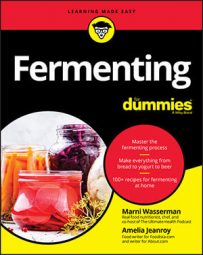You need several types of containers for fermenting. In some recipes, containers may be called vessels. Containers are made of various substances and come in many sizes. Different types of containers are better suited for different fermented foods.
If possible, try to get lids with your containers. You won't always need the lid for sealing the jar, but when you do, it's next to impossible to improvise a tight-fitting lid.
Containers for fermenting can be as large as 20 gallons or as small as a quart. When you begin fermenting you want to stay with smaller containers, such as quart- and gallon-sized containers.
The containers you use for fermenting sit in the same spot for a few days to several weeks, and if that's on a kitchen counter, it could make for some crowded conditions. Even when fermenting for a large family, using smaller containers is still prudent because doing so ensures faster consumption of one jar while the next one finishes working. Plus, smaller containers are simply easier to manage.
Here's a look at some types of containers.
Metal containers for fermentation
Commonly used for brewing, metal vessels provide a clean surface for fermenting any foods. Stainless steel is the best choice for a metal container. Enamel over steel is a good choice if the enamel has no chips on the interior surfaces. Chipped areas may rust, which isn't good for your food. Be careful to avoid metals like cast-iron, copper, aluminum, and tin, all of which can react with the acids in fermented food and give it a strange flavor or cause a color change. These metals can also leach into the food.
Don't use containers coated with Teflon or other nonstick coatings. The coating starts to peel away almost immediately, and then you consume it in the food. And these containers often have metal under the coating that's reactive to the acidic environment of fermentation, resulting in off flavors or colors in your recipe.
Fermenting food in plastic containers
You use plastic containers for some parts of the brewing process and for fermenting fruits and vegetables. Make sure you choose food-grade plastic that's BPA-free.
BPA products contain bisphenol A, a chemical compound that has been linked to health conditions such as infertility, cardiovascular problems, and diabetes.
Wooden containers for fermenting food
You typically use wooden containers for fermenting wine and beer. Wooden vessels are usually barrels, which come in varying sizes. Wood is difficult to sanitize, and we don't recommend it for most fermenting projects.
Glass containers and fermentation
Glass jars are probably the easiest and most cost-effective vessels for fermenting. They don't hold any odor from previous contents, and you can sterilize them again and again. Canning jars are inexpensive and easy to find in most big-box stores.
You can also repurpose jars from purchased products or use jars that you may have lying around the kitchen. The bonus with glass jars is that they come with lids. Although the lids aren't always high quality and may be tough to clean properly, the glass jar itself is worth saving.
Food fermenting in ceramic containers (crocks)
Using ceramic (also called stoneware) vessels is also a good choice. However, be aware that crocks can be heavy, something to consider if you have to move a crock that's full of product.
When buying ceramic containers from secondhand or antique stores for fermenting purposes, be wary of those that aren't marked food-safe. Many older crocks have glazes that contain lead, which can leach into your recipe and is dangerous. Also, be sure to check crocks carefully for cracks, which make the crock impossible to clean well and may cause liquid to seep out during the fermenting process.
Many hardware stores carry lead-testing kits that detect the presence of lead in an object. When in doubt, use caution.

